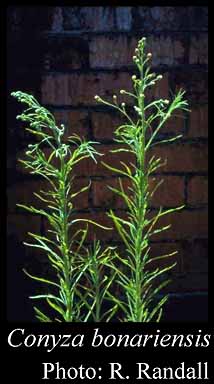This name is not current. Find out more information on related names.
- Reference
- Bull.Torrey Bot.Club 70:632 (1943)
- Conservation Code
- Not threatened
- Naturalised Status
- Alien to Western Australia
- Name Status
- Not Current
Erect annual, herb, 0.15-1.5 m high. Fl. white, Jan to Dec. Variety of soils. Weed of cultivation, waste places & roadsides.

Management Notes (for the Swan NRM Region)
Alternative Names. Argentine Fleabane, Wavy-leaf Fleabane.
General Biology. Growth form. Herb. Life form. Annual. Reproduction. Seed. Dispersal. Wind, water run-off. Seedbank persistence. At least 3 years. Fire response. Likely resprouts.
Notes. Does not compete well under high plant density or cover and requires disturbance to establish and persist. Light stimulates germination. Soil type and burial depth has significant effects on seed persistence and emergence. Predominantly emerges from the soil surface or burial depths of 0.5 cm. Has small lightweight seed that allows it to readily be dipersed long distances. Some biotypes have herbicide-resistance in parts of the world, however no glyphosate-resistant Conyza populations are recorded in the southeast of Western Australia.
Additional information. Origin. Neotropics. Similar exotic species. Conyza sumatrensis, C. parva, C. canadensis.
Suggested method of management and control. Generally more difficult to control than other species of Fleabane. Hand remove small and/or isolated infestations prior to seed set. Resprouts from basal buds after top removal. Timing of application is key to the efficacy of any herbicide treatment. Most susceptible to glyphosate at the rosette stage and least susceptible at flowering. Apply glyphosate when plants are small (at rosette stage <10cm across) 25 ml/ 10L after stem elongation and before flowering and actively growing. Otherwise 50% glyphosate can be used to wipe the stems of plants. At later stages, it is difficult to control with any single herbicide treatment. Read the manufacturers' labels and material safety data sheets before using herbicides. For further information consult the Australian Pesticides and Veterinary Medicines Authority to determine the status of permits for your situation or state.
Management Calendar
| Calendar Type | Jan | Feb | Mar | Apr | May | Jun | Jul | Aug | Sep | Oct | Nov | Dec | Comments |
|---|---|---|---|---|---|---|---|---|---|---|---|---|---|
| Germination | O | Y | Y | Y | O | O | O | O | |||||
| Active Growth | O | Y | Y | Y | Y | Y | Y | ||||||
| Flowering | Y | Y | Y | Y | Y | O | O | O | Y | Y | Y | Y | |
| Fruiting | Y | Y | Y | ||||||||||
| Herbicide Treatment | Y | Y | Y | Y | |||||||||
| Manual Removal | O | O | O | O | O | Y | Y | Y | Y | O | O | O |
Legend: Y = Yes, regularly, O = Occasionally, U = Uncertain, referred by others but not confirmed.
References
- Brown, K. & Brooks, K. (2002) Bushland Weeds: A Practical Guide to their Management. Environmental Weeds Action Network, Greenwood.
- Ferreira, E.A., Aspiazú, I., Silva, A.A., Concenço, G., Silva, A.F., Oliveira, J.A. & Vargas, L. (2008) Glyphosate translocation in hairy fleabane (Conyza bonariensis) biotypes. Planta Daninha, 26 (3).
- Gonzlez-Torralva, F.,Cruz-Hipolito, H., Bastida, F., Mlleder, N., Smeda, R.J. & De Prado, R. (2010) Differential susceptibility to glyphosate among the Conyza weed species in Spain. Journal of Agricultural and Food Chemistry, 58 (7): 4361-4366.
- Hussey, B.M.J., Keighery, G.J., Dodd, J., Lloyd, S.G. & Cousens, R.D. (2007) Western Weeds. A guide to the weeds of Western Australia. 2nd Edition. The Plant Protection Society of Western Australia, Victoria Park.
- Karlsson, l.M. & Milberg, P. (2007) Comparing after-ripening response and germination requirements of Conyza canadensis and C. bonariensis (Asteraceae) through logistic functions. Weed Research, 47: 433-441.
- Lazaroto, C.A., Fleck, N.G. & Vidal, R.A. (2008) Biology and ecophysiology of hairy fleabane (Conyza bonariensis) and horseweed (Conyza canademis). Ciencia Rural, 38 (3): 852-860.
- Moore, C.B. & Moore, J.H. (2002) Herbiguide, the pesticide expert on a disk. Herbiguide, PO Box 44 Albany, Western Australia, 6330.
- Owen, M.J. (2009) A survey in the southern grain belt of Western Australia did not find Conyza spp. resistant to glyphosate. Weed Technology, 23 (3): 492-494.
- Prieur-Richard, A., Lavorel, S., Dos Santos, A. & Grigulis, K. (2002) Mechanisms of resistance of Mediterranean annual communities to invasion by Conyza bonariensis: effects of native functional composition. Oikos, 99: 338-346.
- Swarbrick, J.T. & Skarratt, D.B. (1994) The bushweed 2 database of environmental weeds in Australia. The University of Queensland, Gatton College.
- USDA, ARS, National Genetic Resources Program (2009) Germplasm Resources Information Network - (GRIN). National Germplasm Resources Laboratory, Beltsville, Maryland. URL: https://npgsweb.ars-grin.gov/gringlobal/taxon/taxonomysimple.aspx - Accessed October 2009.
- Weaver, S.E. (2001) The biology of Canadian Weeds. 115. Conyza canadinensis. Canadian Journal of Plant Science, 81 (4): 867-873.
- Werth, J., Walker, S., Boucher, L. & Robinson, G. (2010) Applying the double knock technique to control Conyza bonariensis. Weed Biology and Management, 10 (1): 1-8.
- Wu, H. (2007) The biology of Australian weeds 49. Conyza bonariensis (L.) Cronquist. Plant Protection Quarterly, 22 (4): 122-131.
- Wu, H., Walker, S. & Robinson, G. (2008) Chemical control of Flaxleaf Fleabane (Conyza bonariensis (L.) Cronquist) in winter fallows. Plant Protection Quarterly, 23 (4): 162-165.
- Wu, H., Walker, S., Rollin, M.J., Tan, D.K.Y., Robinson, G. & Werth, J. (2007) Germination, persistence, and emergence of flaxleaf fleabane (Conyza bonariensis [L.] Cronquist). Weed Biology and Management, 7 (3): 192 - 199.